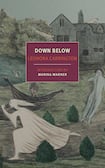
On the centenary of her birth, the late surrealist artist and writer Leonora Carrington is the talk of the town. Joining the gush of reissued fiction, memoirs and articles in the press about Carrington's work and colourful life comes this NYRB Classics reissue, an account of the madness Carrington endured in France and Spain during the second World War.
As Marina Warner acknowledges in her lengthy, useful introduction, Down Below is not representative of Carrington's writing; indeed, she did not even write it, exactly. Having lost an early draft, she dictated her experiences to a physician friend and his wife, who then knocked it out in book form. Decades later, in the 1980s, Carrington dictated a postscript to Marina Warner. The text amounts to a little under 70 pages.
True enough, the sharp wit and droll absurdism of Carrington's novel The Hearing Trumpet, and such short stories as The Debutante, are absent here. Down Below is earnest and humourless, the nature of the experiences being described leaving little alternative.
Born into mansion-dwelling privilege in Lancashire in 1917, to a mythically-inclined Irish mother and a tycoon father, Carrington had no use for the gilded, stuffy life that was laid out for her. Such stories as the aforementioned The Debutante suggest depths of savagery and appetite beneath the conventions of upper-class Englishness.
What interested young Leonora was art in general and surrealism in particular. When she met the German painter Max Ernst at an exhibition at age 19 – Ernst was 46 – they immediately became lovers. She moved with him to rural France, where they enjoyed a playful period of creativity, illustrious guests and surrealist shenanigans. Some rather sexy photographs by Lee Miller survive of what turned out to be a prelapsarian idyll.
Unhinged in prison
When war came, Ernst was arrested and imprisoned, first by the French authorities, then by the German occupying forces. Alone in Provence, the highly sensitive Carrington became unhinged. Down Below illustrates the inner landscape of her psychotic disintegration, and her painful confinement in a Spanish mental institution. At one point, she matter-of-factly recounts being gang-raped by Spanish officers and then dropped off in a Madrid park where she "wandered about, lost, my clothes torn".
What makes the first part of this narrative so arresting is the sense that Carrington’s insanity is the interior reverberation of a macrocosmic derangement. As the armies of Europe pour across borders in an orgy of generalised slaughter, the apocalyptic backdrop suggests that Carrington’s madness is, in a sense, objective. Her account captures both the intense drama and megalomaniacal ridiculousness of psychotic breakdown. The universe is in danger of being crushed, the cosmic order is unravelling – and it’s all about her.
“I was destined to bring Knowledge,” she explains (the prose is flecked with earnest New Agey capitalisations). Seeking “the solution to many cosmic problems”, she undertakes “a journey into the Unknown”, and is propped up by her “Stick of Philosophy”. In addition to restoring order to the turbulent Cosmos, poor mad Leonora also takes it on herself to broker peace between Europe’s nations and “make peace on earth”. “I worshipped myself at such moments,” she tells us, understandably.
A woman’s perspective
The surrealist movement revered madness as a rupture in the matrix of rationality, which alienated mankind from its true powers, perceptions and creativity – all the dark swarming force of the unconscious. André Breton's novel Nadja recounts his enchantment with a young woman spiralling into insanity akin to Carrington's. Down Below counters that book with an un-romanticised female perspective.
Like other field guides to the far side of reason, including Carl Jung's The Red Book, the ballet dancer Nijinsky's diaries and Philip K Dick's novel Valis, Down Below impresses through the sheer baroque vividness of the madness it describes. With a faint hazing of perspective, it reads like an account of visionary experience, a shamanic voyage to hidden worlds. A century after the heyday of surrealism, we still cannot shake the suspicion that in the ravings of the lunatic lie coded traces of a higher reality. Madness speaks to a primal, shadowy part of our psyche as a condensed lexicon of more or less brilliant metaphors, conducting truth from the pulsating core of being.
In the postscript, Carrington recounts her escape from Europe with Max Ernst, his new lover Peggy Guggenheim, and her own husband-of-convenience, a Mexican named Renato Leduc. She settled in Mexico and, after the period covered by this memoir, became a surrealist artist of renown. Feeding her fascination with esotericism, magic and renegade metaphysics, she delighted in a friendship with the similarly liminal painter Remedios Varo.
The renewed interest in Carrington's otherworldly art is welcome, and Down Below is a valuable report from a descent into the unspeakable.
Rob Doyle's most recent book, This Is the Ritual, is published by Bloomsbury and the Lilliput Press












